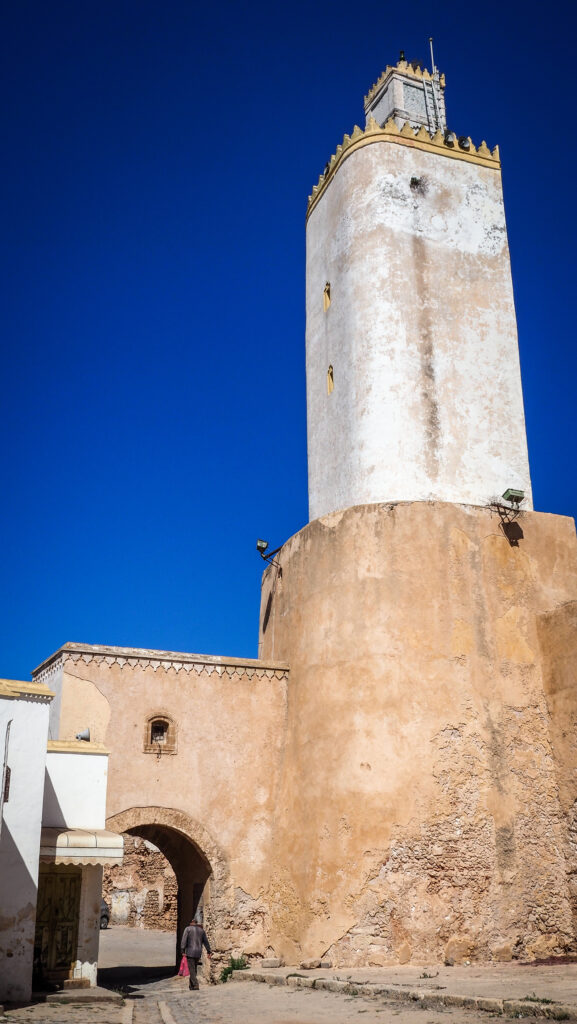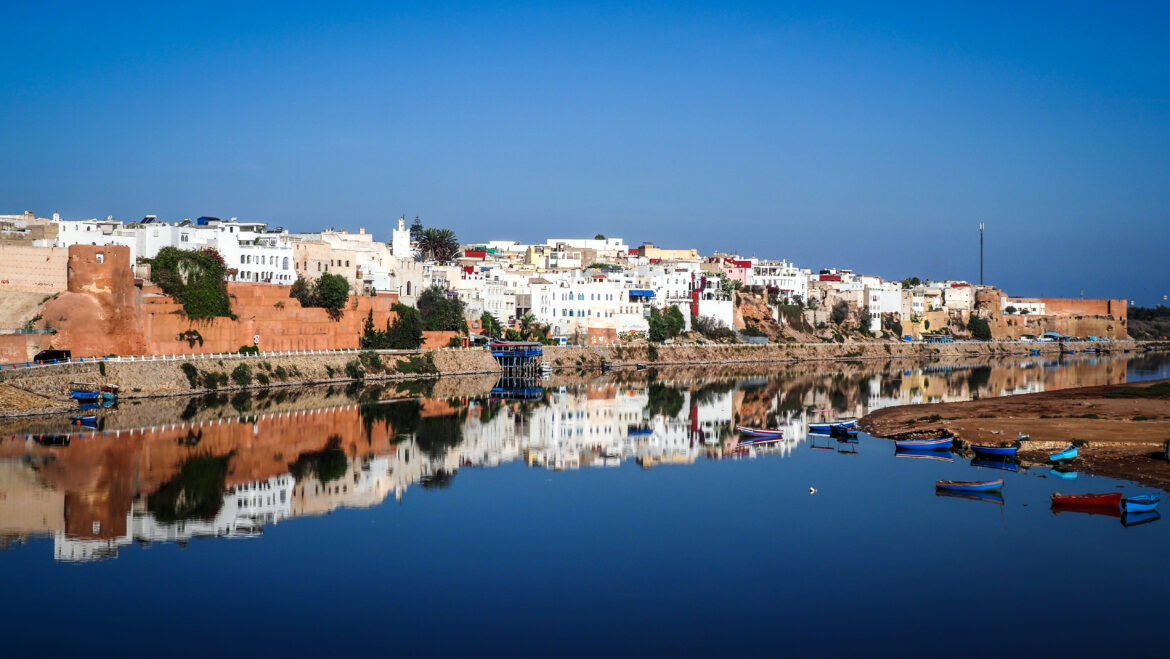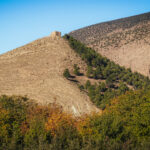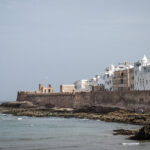Azemmour is a historic town located on the Atlantic coast of Morocco, situated about 75 kilometres southwest of Casablanca and near the mouth of the Oum Er-Rbia River. It has a long history, dating back to the Phoenician and Roman periods. It gained prominence during the Islamic period, especially under the Almohad and Merinid dynasties. The town was known for its strategic importance and was a notable centre for trade and commerce.
In the early 16th century, the town was captured by the Portuguese, who built fortifications and left a lasting architectural imprint. They held Azemmour from 1513 until they abandoned it in 1541. That’s why the town features a mix of Moroccan and Portuguese architecture. Notable landmarks include the old medina with its narrow streets and traditional houses, the Portuguese fortress, and the Kasbah, which offers a panoramic view of the Oum Er-Rbia River.

El Jadida is also a coastal city, located about 17 kilometres south of Azzemour. It is the capital of the El Jadida province in the Casablanca-Settat region.
In 1502, the Portuguese established a fortified city called Mazagan on the site. The fortifications were completed in 1541 and included impressive bastions, ramparts, and a cistern, which remains a notable architectural feature. The city served as an important trading post and military stronghold, playing a crucial role in the Portuguese Empire’s presence in Morocco.
In 1769, after more than 250 years of Portuguese control, the city was recaptured by the forces of Sultan Mohammed ben Abdallah of Morocco. The Portuguese, anticipating the siege, destroyed parts of the fortifications before leaving, but the city was soon rebuilt and renamed El Jadida, meaning “The New”.
In 1912, Morocco became a French Protectorate, and El Jadida, like many other Moroccan cities, underwent significant urban development under French influence. The city’s infrastructure improved, and it continued to thrive as a commercial port.
Following Morocco’s independence in 1956, El Jadida continued to grow and modernize. Today, it is a popular tourist destination known for its historical sites, including the Portuguese Cistern and the old fortress, which are part of the UNESCO World Heritage-listed Portuguese City of Mazagan.
How to get there?
From Casablanca:
By Car:
From Casablanca, drive southwest on the A5 motorway. The distance is approximately 75 kilometres and takes about 1 hour. Take the exit toward Azemmour and follow the signs to the town centre.
By Train:
Take a train from Casa Voyageurs or Casablanca Port stations to Azemmour. The journey usually takes around 1 to 1.5 hours. The Moroccan railway operator ONCF runs frequent trains between these destinations. Once at the Azemmour train station, you can take a taxi to reach the town centre or just walk.
By Bus:
Various bus companies operate services from Casablanca to Azemmour. The trip duration is around 1.5 to 2 hours, depending on traffic and the bus company.
From Azzemour to El Jadida:
By Car:
Drive northeast on the N1 road. The distance is about 17 kilometres and takes approximately 20 minutes.
By Train:
Take a local train from El Jadida to Azemmour. The travel time is around 20-30 minutes. Check the ONCF (Office National des Chemins de Fer) website or visit a local train station for updated schedules and ticket prices.
By Bus:
Some buses go along Boulevard Mohammed V in Azzemour and go all the way to El Jadida. Look for bus stops or ask locals for directions.
By Taxi:
Grand taxis (shared taxis) are available and can take you from El Jadida to Azemmour. The ride is short and inexpensive.
You may check your connections at 12go.com.
The best time to visit
The best time to visit both cities is during the spring (March to May) and fall (September to November) when the weather is mild and pleasant. Summer can be quite hot, while winter brings cooler but still enjoyable temperatures. Choosing spring or fall ensures a comfortable climate for enjoying the beach and exploring the cities and their surroundings.

Where to stay?
I decided to stay in Hotel Dar Aboulanwar in El Jadida which is not in the city centre but easily accessible by taxi for a few dirhams. The room and bathroom were super spacious and impeccably clean!
How long to stay there?
If you start early enough, both cities can be visited comfortably in one long day.
What to see in Azzemour?
I actually decided to ignore all the vigorous taxi drivers at the train station and simply walked to the city centre. First, I made a stop at Mohamed V Bridge, to admire the panorama of the city walls and the Oum Er-Rbia River. Well worth it!
Then I proceed to the medina, which is a highlight of the city. Constructed in the 16th century close to the banks of the Er-Rbia, it still has some of its Portuguese heritage, particularly in the elaborate doors. Locals have a long history of being involved in the arts and handicrafts so you may witness them weaving colourful textiles. It was also much fun to discover enormous murals that cover decaying buildings.
At some point, my peaceful exploring was interrupted by some dude who was following me and kept insisting on being my guide. Super annoying but that is how it works in Morocco so you either have to refuse strongly, or agree but negotiate the price beforehand. He did indeed tell me some interesting facts but of course, the whole ‘tour’ was rushed as he wanted to get rid of me as soon as possible.



We strolled around the Grand Mosque, Kasbah Mosque (fr. Mosquée de la Kasbah) and the Shrine of Rabbi Braham Moul Ness, which comprises several rooms, some subterranean, containing artefacts and books in Hebrew. On the corniche, there are some simple places for tea or coffee with views over the river and fortifications. You can also take a boat trip.
I left medina through the gate towards Av. Allal Ben Abdellah. The city walls on that side were quite impressive. I didn’t have any idea how to get to El Jadida so I simply started walking along Boulevard Mohammed V trying to hitchhike but my presence was totally ignored by all drivers. After 15 minutes, some guy approached me and said that there was a bus stop a few hundred meters away and regular buses head to El Jadida from there. Lucky me!



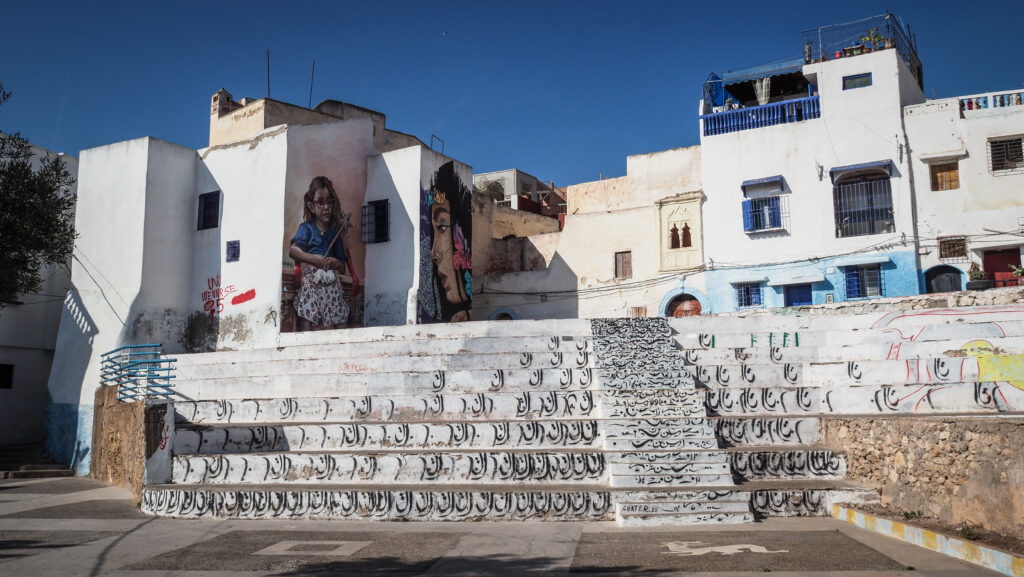
What to see in El Jadida?
I started exploring the town by walking along the Corniche, with El Jadida Beach to the right. A few people were chilling under umbrellas but at this time of the year (October), it was quite empty. There is Mohammed V Park on the other side of the road but unfortunately, there is lots of trash around.
Then, I walked into the remains of the Portuguese Fortress. Notable structures include the Portuguese Cistern, the Church of the Assumption, and the city’s fortified walls. The main entrance is from the side of Av. de Suez and to the left of the main gate you will see the beautiful door which is the entrance to the old mosque.
The Church of the Assumption is an old Portuguese church from the 16th century, currently transformed into a theatre. It’s rarely open so you rather won’t have the chance to peek inside.



A bit further is the cistern, which was built beneath the Citadel before it was enlarged into the greater walled fortification in 1541. It’s unclear what the chamber’s initial purpose was. It may have served as a granary, armoury, or barracks, but in 1541 it was documented as being transformed into a cistern. It has served as a filming setting for several films, the most well-known worldwide being Orson Welles’ Othello. As of October 2023, the building was closed for renovation.
Go past the Spanish Chapel and continue to the city walls. It’s free to access and it’s fun to walk around, even though it’s not possible to do the full loop.


